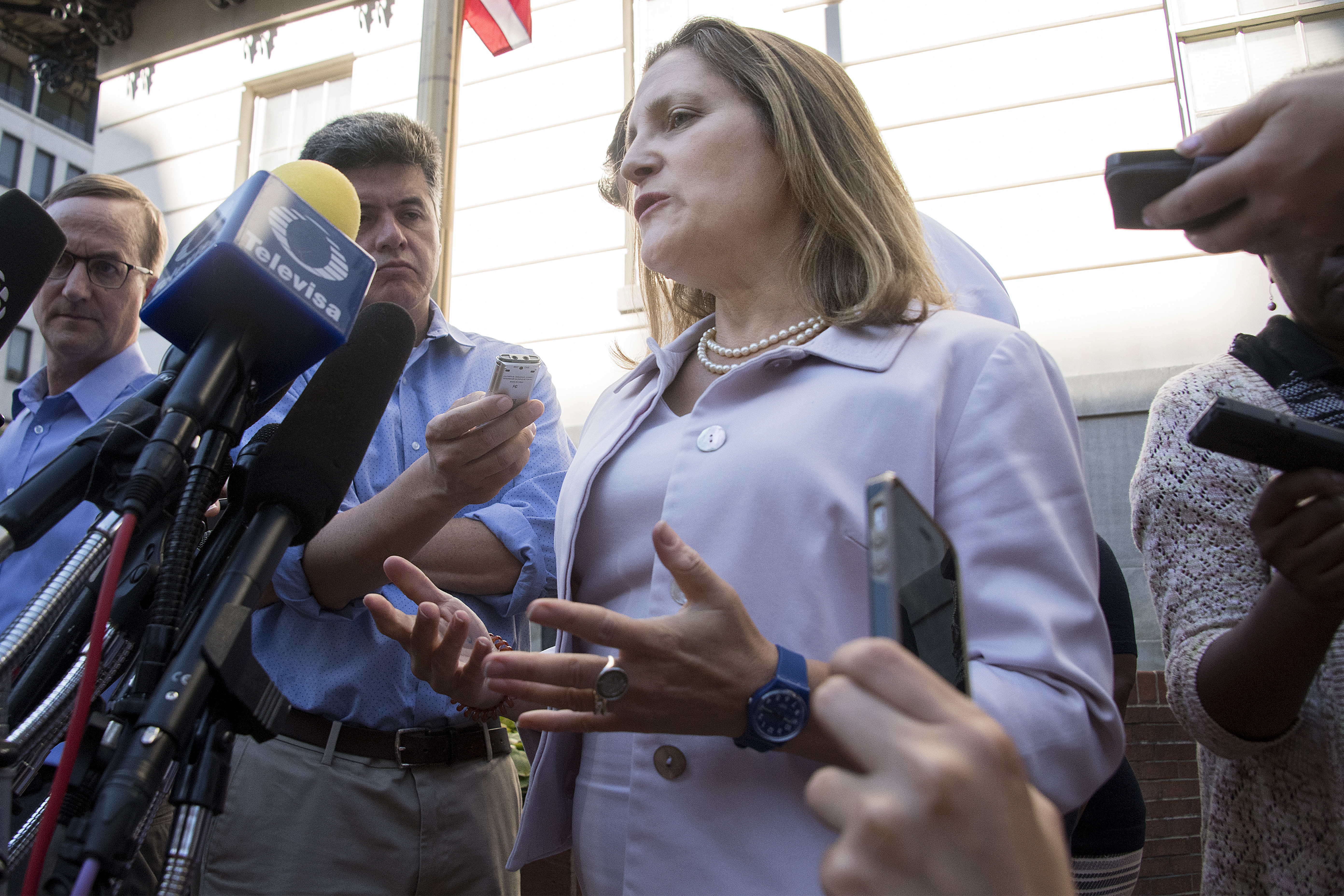US-Canada NAFTA talks to resume Friday as deadline looms
Canadian Foreign Affairs Minister Chrystia Freeland will meet again with US Trade Representative Robert Lighthizer after making progress in three days of NAFTA talks (Jim WATSON)
Washington (AFP) – With Friday’s deadline fast approaching, talks continued late into the night on Thursday without reaching a deal between Canada and the US on an overhaul of the North American Free Trade Agreement.
Canada’s Foreign Minister Chrystia Freeland held four meetings Thursday with US Trade Representative Robert Lighthizer to try to bridge differences to preserve the three-nation trade pact with the US and Mexico.
But, after the last meeting ended, Freeland told reporters: “No we don’t have a deal.”
However, she said, “discussions continue tomorrow.”
The White House plans to notify Congress on Friday of its intention to enter into a new free trade agreement, to provide the required 90 days’ notice that would allow NAFTA 2.0 to be signed by December 1, when Mexico will install a new president.
President Donald Trump has threatened to leave Canada on the sidelines since announcing a breakthrough with Mexico on Monday, but the US president and Canadian Prime Minister Justin Trudeau both have expressed optimism a deal is close.
“We are replacing NAFTA with a beautiful, brand new US-Mexico trade deal,” Trump told a crowd in Evansville, Indiana Thursday night.
On Canada, he said: “I think it is going to happen and we really have developed a really good relationship. But they have to treat us fairly. They haven’t treated us fairly.”
The crucial phase of the US-Canada talks began Tuesday, after Mexican officials spent five weeks shuttling to Washington to work out key issues on auto trade and worker rights.
In a strange twist on the third day of talks, Freeland emerged from the final late night meeting after only a few minutes, saying she just had a few things to tell Lighthizer.
But earlier she told reporters the sides were “making progress,” and had “covered a lot of ground.”
Officials will need to find compromises on issues that have created friction between the neighboring countries, notably Canada’s dairy trade rules and mechanisms to settle disputes and intellectual property protections.
Freeland has declined to comment on the specific issues being discussed, saying officials had agreed “we are not going to conduct our negotiation in public.”
– Clock ticking –
Negotiators have worked for a year to update and rewrite the 25-year-old free trade pact, but have rushed in the past six weeks to get it across the goal line.
If the White House notifies Congress by Friday, it then would have until September 30 to submit the final NAFTA agreement, but the sides will have to have the major points ironed out.
Ottawa and Washington seem upbeat about the chances of reaching a deal, but Trump is due to leave Washington just after midday on Friday for an event in North Carolina, which may add to the time pressures if the US president wants to be the one to announce any agreement.
The sticking points between Ottawa and Washington center on Canada’s managed dairy market — something Trump has criticized frequently — and how to handle some disputes among NAFTA partners, as well as patent protections for medicines.
Trudeau has vowed not to give in to Washington’s demands to alter the system under which Ottawa sets dairy production quotas and prices, with steep tariffs on imports.
But Ottawa could offer US dairy farmers a small increase in market share as it did with the EU in a free trade pact last year, in exchange for US concessions on the NAFTA chapter on dispute resolution.
Freeland said she had remained in close touch with her Mexican and US counterparts throughout the summer and had already achieved “a high-level agreement with the US” on some of the pending issues on autos and labor rights.
She also met this week with her Mexican counterparts, who remained in Washington after announcing the breakthrough deal with the United States.
Mexico’s Economy Minister Ildefonso Guajardo said he expected to rejoin his US and Canadian counterparts for trilateral talks.
The new NAFTA includes a higher percentage of locally-produced components in autos, a requirement that a percentage of vehicles must come from high wage factories, tougher worker protections and a provision to review the 16-year deal every six years.
Disclaimer: This story has not been edited by Siliconeer and is published from a syndicated feed. Siliconeer does not assume any liability for the above story. Validity of the above story is for 7 Days from original date of publishing. Content copyright AFP.


